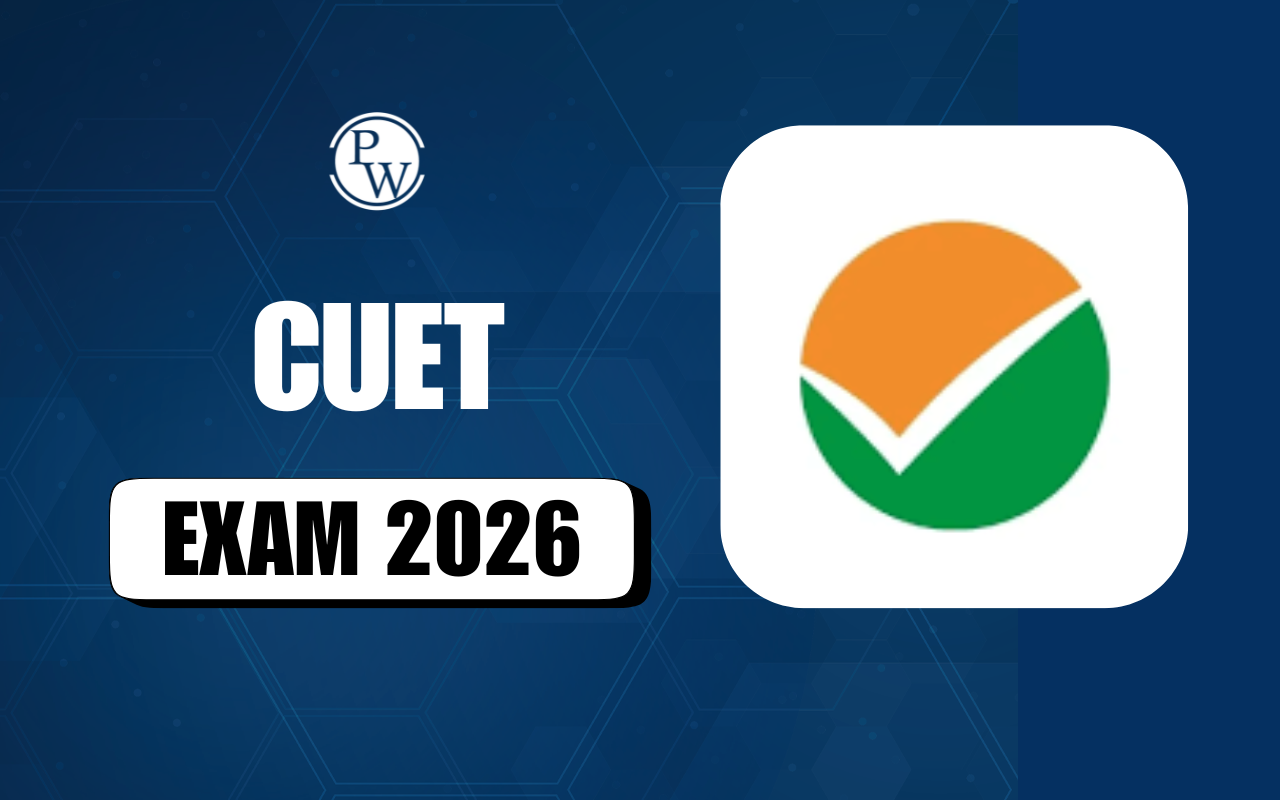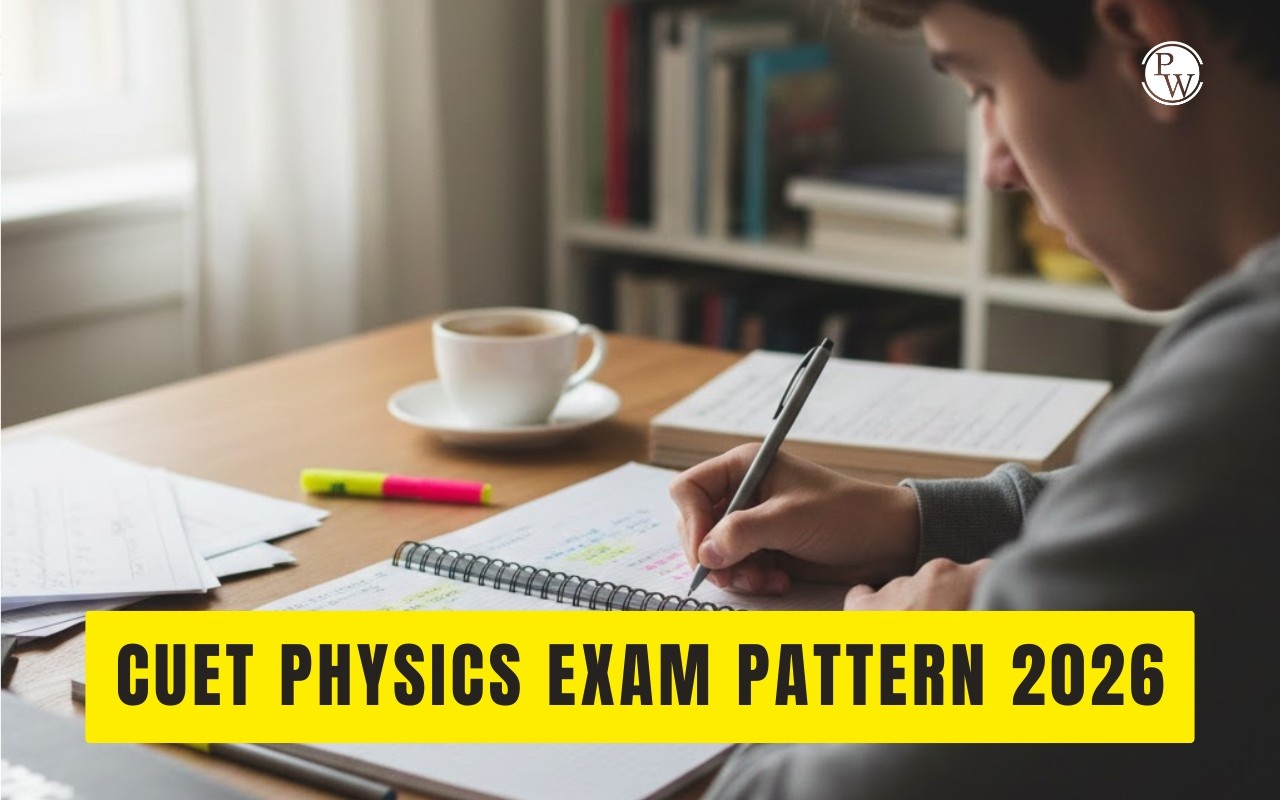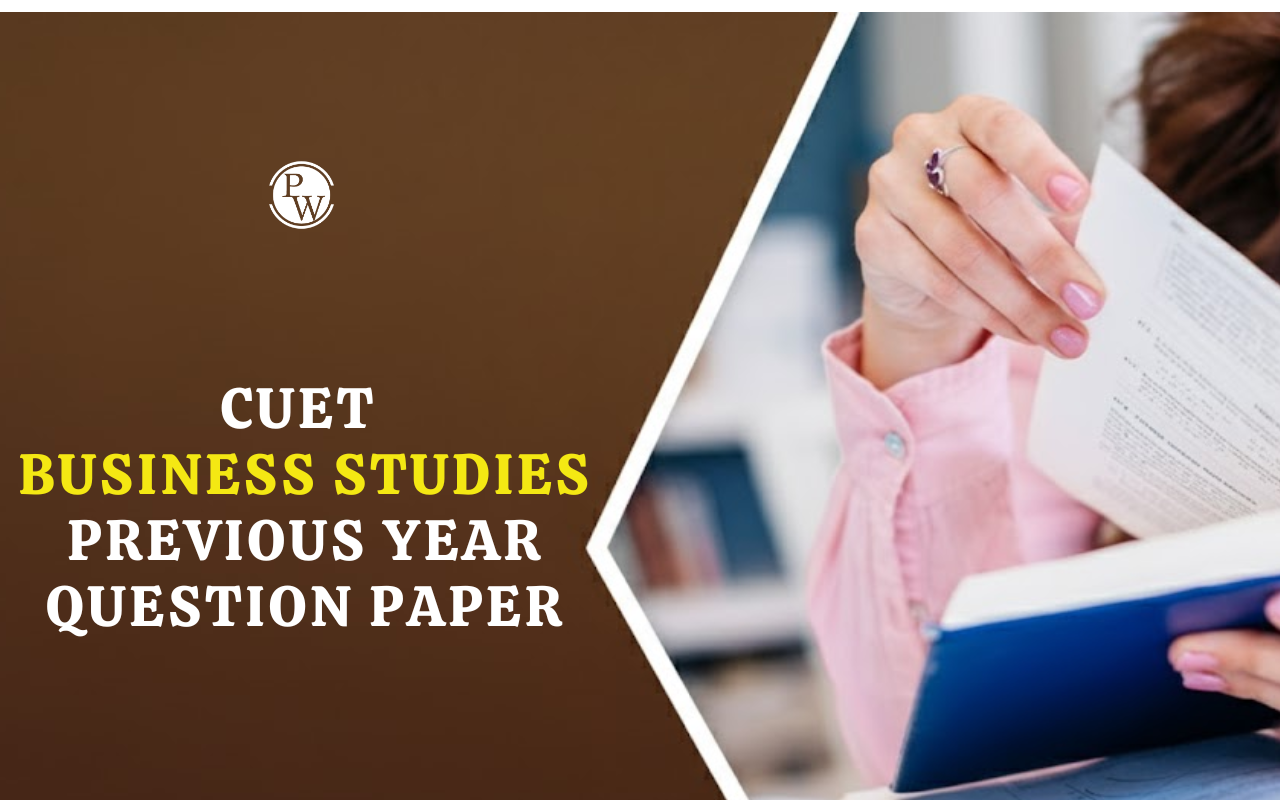
CUET 2025 Syllabus for PCM : The CUET 2025 syllabus for students opting for the Physics, Chemistry, and Mathematics (PCM) stream is based on the Class 12 NCERT curriculum. The syllabus for Physics includes topics like Mechanics, Electricity and Magnetism, Optics, Modern Physics, and Thermodynamics. For Chemistry, it covers Organic, Inorganic, and Physical Chemistry, including topics like Chemical Bonding, States of Matter, Redox Reactions, and Chemical Kinetics. The Mathematics syllabus focuses on topics such as Algebra, Calculus, Vectors, Three-Dimensional Geometry, Probability, and Differential Equations. The exam assesses a deep understanding of these subjects, and students are advised to thoroughly prepare using the NCERT textbooks and practice problem-solving to ensure a strong performance in the exam.
CUET 2025 Syllabus For PCM
Interested candidates can check CUET 2025 Syllabus for Physics, Chemistry, and Mathematics below. The subject-wise important topics are listed here.
CUET 2025 Syllabus for Physics
Candidates can check CUET 2025 Syllabus for Physics subject below. The Physics syllabus includes topics such as Electrostatics, Current Electricity, Optics, Electromagnetic Waves, Communication Systems, etc.
CUET 2025 Syllabus for Physics Unit I : Electrostatics
- Electric charges and their conservation. Coulomb’s law – force between two point charges, forces between multiple charges; superposition principle, and continuous charge distribution.
- Electric field, electric field due to a point charge, electric field lines; electric dipole, electric field due to a dipole; torque on a dipole in a uniform electric field.
- Electric flux, statement of Gauss’s theorem and its applications to find field due to an infinitely long straight wire, uniformly charged infinite plane sheet, and uniformly charged thin spherical shell (field inside and outside).
- Electric potential, potential difference, electric potential due to a point charge, a dipole, and system of charges; equipotential surfaces, the electrical potential energy of a system of two point charges, and electric dipoles in an electrostatic field.
- Conductors and insulators, free charges, and bound charges inside a conductor. Dielectrics and electric polarization, capacitors and capacitance, the combination of capacitors in series and in parallel, the capacitance of a parallel plate capacitor with and without dielectric medium between the plates, energy stored in a capacitor, Van de Graaff generator.
CUET 2025 Syllabus for Physics Unit II : Current Electricity
- Electric current, the flow of electric charges in a metallic conductor, drift velocity and mobility, and their relation with electric current; Ohm’s law, electrical resistance, V-I characteristics (linear and non-linear), electrical energy and power, electrical resistivity, and conductivity.
- Carbon resistors, color code for carbon resistors, series and parallel combinations of resistors, temperature dependence of resistance. The internal resistance of a cell, potential difference, and emf of a cell, combination of cells in series and in parallel.
- Kirchhoff ’s laws and simple applications. Wheatstone bridge, metre bridge. Potentiometer – principle and applications to measure potential difference, and for comparing emf of two cells; measurement of internal resistance of a cell.
CUET 2025 Syllabus For Physics Unit III : Magnetic Effects of Current and Magnetism
- Concept of the magnetic field, Oersted’s experiment. Biot - Savart law and its application to current carrying circular loop.
- Ampere’s law and its applications to infinitely long straight wire, straight and toroidal solenoids. Force on a moving charge in uniform magnetic and electric fields. Cyclotron.
- Force on a current-carrying conductor in a uniform magnetic field. The force between two parallel current-carrying conductors – definition of ampere. Torque experienced by a current loop in a magnetic field; moving coil galvanometer – its current sensitivity and conversion to ammeter and voltmeter.
- Current loop as a magnetic dipole and its magnetic dipole moment. The magnetic dipole moment of a revolving electron. Magnetic field intensity due to a magnetic dipole (bar magnet) along its axis and perpendicular to its axis. Torque on a magnetic dipole (bar magnet) in a uniform magnetic field; bar magnet as an equivalent solenoid, magnetic field lines; Earth’s magnetic field and magnetic elements.
- Para-, dia- and ferromagnetic substances, with examples. Electromagnets and factors affecting their strengths. Permanent magnets.
CUET 2025 Syllabus For Physics Unit IV : Electromagnetic Induction and Alternating Currents
Electromagnetic induction; Faraday’s law, induced emf and current; Lenz’s Law, Eddy currents. Self and mutual inductance. Alternating currents, peak and rms value of alternating current/voltage; reactance and impedance; LC oscillations (qualitative treatment only), LCR series circuit, resonance; power in AC circuits, wattless current. AC generator and transformer.
CUET 2025 Syllabus For Physics Unit V: Electromagnetic Waves
- Need for displacement current. Electromagnetic waves and their characteristics (qualitative ideas only). Transverse nature of electromagnetic waves.
- Electromagnetic spectrum (radio waves, microwaves, infrared, visible, ultraviolet, x-rays, gamma rays) including elementary facts about their uses.
CUET 2025 Syllabus For Physics Unit VI : Optics
- Reflection of light, spherical mirrors, mirror formula. Refraction of light, total internal reflection and its applications, optical fibers, refraction at spherical surfaces, lenses, thin lens formula, lens maker's formula. Magnification, power of a lens, combination of thin lenses in contact, combination of a lens and a mirror. Refraction and dispersion of light through a prism.
- Scattering of light–blue color of the sky and reddish appearance of the sun at sunrise and sunset.
- Optical instruments: Human eye, image formation and accommodation, correction of eye defects (myopia and hypermetropia) using lenses.
- Microscopes and astronomical telescopes (reflecting and refracting) and their magnifying powers.
- Wave optics: Wavefront and Huygens’ principle, reflection, and refraction of plane wave at a plane surface using wavefronts.
- Proof of laws of reflection and refraction using Huygens’ principle.
- Interference, Young’s double hole experiment and expression for fringe width, coherent sources, and sustained interference of light.
- Diffraction due to a single slit, width of central maximum.
- Resolving the power of microscopes and astronomical telescopes. Polarisation, plane polarised light; Brewster’s law, uses of plane polarised light and Polaroids.
CUET 2025 Syllabus For Physics Unit VII : Dual Nature of Matter and Radiation
- Photoelectric effect, Hertz and Lenard’s observations; Einstein’s photoelectric equation – particle nature of light.
- Matter waves – wave nature of particles, de Broglie relation. Davisson-Germer experiment (experimental details should be omitted; only the conclusion should be explained.)
CUET 2025 Syllabus For Physics Unit VIII: Atoms and Nuclei
- Alpha - particle scattering experiment; Rutherford’s model of atom; Bohr model, energy levels, hydrogen spectrum. Composition and size of nucleus, atomic masses, isotopes, isobars; isotones.
- Radioactivity – alpha, beta, and gamma particles and rays and their properties; radioactive decay law. Massenergy relation, mass defect; binding energy per nucleon and its variation with mass number; nuclear fission and fusion.
CUET 2025 Syllabus For Physics Unit IX : Electronic Devices
- Energy bands in solids (qualitative ideas only), conductors, insulators, and semiconductors; semiconductor diode – I-V characteristics in forward and reverse bias, diode as a rectifier; I-V characteristics of LED, photodiode, solar cell, and Zener diode; Zener diode as a voltage regulator. Junction transistor, transistor action, characteristics of a transistor; transistor as an amplifier (common emitter configuration) and oscillator. Logic gates (OR,AND, NOT, NAND and NOR). Transistor as a switch.
CUET 2025 Syllabus For Physics Unit X: Communication Systems
- Elements of a communication system (block diagram only); bandwidth of signals (speech, TV, and digital data); bandwidth of transmission medium. Propagation of electromagnetic waves in the atmosphere, sky, and space wave propagation. Need for modulation. Production and detection of an amplitude-modulated wave.
CUET 2025 Syllabus For Chemistry
Candidates can check CUET 2025 Syllabus for Chemistry subject below. The Chemistry syllabus includes topics such as Solid State, Solutions, Electrochemistry, Chemical Kinetics, Surface Chemistry, etc.
| CUET 2025 Syllabus for Chemistry | |
| Units | Topics |
| Unit I: Solid State | Classification of solids based on different binding forces: molecular, ionic covalent, and metallic solids, amorphous and crystalline solids(elementary idea), unit cell in two-dimensional and three-dimensional lattices, calculation of density of unit cell, packing in solids, packing efficiency, voids, number of atoms per unit cell in a cubic unit cell, point defects, electrical and magnetic properties, Band theory of metals, conductors, semiconductors and insulators and n and p-type semiconductors. |
| Unit II: Solutions | Types of solutions, expression of concentration of solutions of solids in liquids, the solubility of gases in liquids, solid solutions, colligative properties – the relative lowering of vapour pressure, Raoult’s law, elevation of B.P., depression of freezing point, osmotic pressure, determination of molecular masses using colligative properties, abnormal molecular mass, Vant Hoff factor. |
| Unit III: Electrochemistry | Redox reactions; conductance in electrolytic solutions, specific and molar conductivity variations of conductivity with concentration, Kohlrausch’s Law, electrolysis and laws of electrolysis (elementary idea), dry cell – electrolytic cells and Galvanic cells; lead accumulator, EMF of a cell, standard electrode potential, Nernst equation and its application to chemical cells. Relation between Gibbs energy change and EMF of a cell, fuel cells; corrosion. |
| Unit IV: Chemical Kinetics | Rate of a reaction (average and instantaneous), factors affecting rates of reaction: concentration, temperature, catalyst; order and molecularity of a reaction; rate law and specific rate constant, integrated rate equations, and half-life (only for zero and first-order reactions); concept of collision theory (elementary idea, no mathematical treatment). Activation energy, Arrhenius equation. |
| Unit V: Surface Chemistry | Adsorption – physisorption and chemisorption; factors affecting adsorption of gases on solids; catalysis: homogenous and heterogeneous, activity and selectivity: enzyme catalysis; colloidal state: the distinction between true solutions, colloids, and suspensions; lyophilic, lyophobic multimolecular and macromolecular colloids; properties of colloids; Tyndall effect, Brownian movement, electrophoresis, coagulation; emulsions – types of emulsions. |
| Unit VI: General Principles and Processes of Isolation of Elements | Principles and methods of extraction – concentration, oxidation, reduction electrolytic method, and refining; occurrence and principles of extraction of aluminium, copper, zinc, and iron. |
| Unit VII: p-Block Elements | Group 15 elements: General introduction, electronic configuration, occurrence, oxidation states, trends in physical and chemical properties; nitrogen – preparation, properties, and uses; compounds of nitrogen: preparation and properties of ammonia and nitric acid, oxides of nitrogen (structure only); Phosphorous-allotropic forms; compounds of phosphorous: preparation and properties of phosphine, halides (PCl3, PCl5) and oxoacids (elementary idea only). Group 16 elements: General introduction, electronic configuration, oxidation states, occurrence, trends in physical and chemical properties; dioxygen: preparation, properties, and uses; classification of oxides; ozone. Sulphur – allotropic forms; compounds of sulphur: preparation, properties, and uses of sulphur dioxide; sulphuric acid: industrial process of manufacture, properties and uses, oxoacids of sulphur (structures only). Group 17 elements: General introduction, electronic configuration, oxidation states, occurrence, trends in physical and chemical properties; compounds of halogens: preparation, properties and uses of chlorine and hydrochloric acid, interhalogen compounds, oxoacids of halogens(structures only). Group 18 elements: General introduction, electronic configuration, occurrence, trends in physical and chemical properties, uses. |
| Unit VIII: d and f Block Elements | General introduction, electronic configuration, occurrence and characteristics of transition metals, general trends in properties of the first-row transition metals – metallic character, ionization enthalpy, oxidation states, ionic radii, colour, catalytic property, magnetic properties, interstitial compounds, alloy formation. Preparation and properties of K2Cr2O7 and KMnO4. Lanthanoids – electronic configuration, oxidation states, chemical reactivity, and lanthanoid contraction and its consequences. Actinoids –Electronic configuration, oxidation states, and comparison with lanthanoids. |
| Unit IX: Coordination Compounds | Coordination compounds: Introduction, ligands, coordination number, colour, magnetic properties and shapes, IUPAC nomenclature of mononuclear coordination compounds, bonding, Werner’s theory VBT, CFT; isomerism (structural and stereo)importance of coordination compounds (in qualitative analysis, extraction of metals and biological systems). |
| Unit X: Haloalkanes and Haloarenes | Haloalkanes: Nomenclature, nature of C-Xbond, physical and chemical properties, mechanism of substitution reactions. Optical rotation. Haloarenes: Nature of C-X bond, substitution reactions (directive influence of halogen for monosubstituted compounds only). Uses and environmental effects of–dichloromethane, trichloromethane, tetrachloromethane, iodoform, freons, DDT. |
| Unit XI: Alcohols, Phenols, and Ethers | Alcohols: Nomenclature, methods of preparation, physical and chemical properties (of primary alcohols only); identification of primary, secondary, and tertiary alcohols; mechanism of dehydration, uses, with special reference to methanol and ethanol. Phenols: Nomenclature, methods of preparation, physical and chemical properties, acidic nature of phenol, electrophilic substitution reactions, uses of phenols. Ethers: Nomenclature, methods of preparation, physical and chemical properties, uses. |
| Unit XII: Aldehydes, Ketones, and Carboxylic Acid | Aldehydes and Ketones: Nomenclature, nature of carbonyl group, methods of preparation, physical and chemical properties, mechanism of nucleophilic addition, the reactivity of alpha hydrogen in aldehydes; uses. Carboxylic Acids: Nomenclature, acidic nature, methods of preparation, physical and chemical properties; uses. |
| Unit XIII: Organic Compounds Containing Nitrogen | Amines: Nomenclature, classification, structure, methods of preparation, physical and chemical properties, uses, identification of primary secondary, and tertiary amines. Cyanides and Isocyanides – will be mentioned at relevant places in context. Diazonium salts: Preparation, chemical reactions, and importance in synthetic organic chemistry |
| Unit XIV: Biomolecules | Carbohydrates – Classification (aldoses and ketoses), monosaccharide (glucose and fructose), D-L configuration, oligosaccharides (sucrose, lactose, maltose), polysaccharides (starch, cellulose, glycogen): importance. Proteins – Elementary idea of a-amino acids, peptide bond, polypeptides, proteins, primary structure, secondary structure, tertiary structure and quaternary structure (qualitative idea only), denaturation of proteins; enzymes. Hormones –Elementary idea (excluding structure). Vitamins – Classification and functions. Nucleic Acids: DNA and RNA |
| Unit XV: Polymers | Classification – Natural and synthetic, methods of polymerization (addition and condensation), copolymerization. Some important polymers: natural and synthetic like polythene, nylon, polyesters, bakelite, rubber. Biodegradable and non-biodegradable polymers. |
| Unit XVI: Chemistry in Everyday Life | Chemicals in Medicines – analgesics, tranquilizers, antiseptics, disinfectants, antimicrobials, antifertility drugs, antibiotics, antacids, antihistamines. Chemicals in Food– preservatives, artificial sweetening agents, elementary idea of antioxidants. Cleansing Agents – soaps and detergents, cleansing action. |
CUET 2025 Syllabus For Mathematics
Candidates can check CUET 2025 Syllabus for Mathematics subject below. The Chemistry syllabus includes topics such as Solid State, Solutions, Electrochemistry, Chemical Kinetics, Surface Chemistry, etc.
CUET 2025 Syllabus For Mathematics Section A
Candidates can check CUET Mathematics Syllabus for Section A in the table below.
| CUET 2025 Syllabus For Mathematics Units | |
| Unit I: Algebra | Unit II: Calculus |
| (i) Matrices and types of Matrices (ii) Equality of Matrices, transpose of a Matrix, Symmetric and Skew Symmetric Matrix (iii) Algebra of Matrices (iv) Determinants (v) Inverse of a Matrix (vi) Solving of simultaneous equations using Matrix Method | (i) Higher order derivatives (ii) Tangents and Normals (iii) Increasing and Decreasing Functions (iv)Maxima and Minima Order and degree of differential equations (ii) Formulating and solving differential equations with variable separable |
| Unit III: Integration and its Applications | Unit IV: Differential Equations |
| (i) Indefinite integrals of simple functions (ii) Evaluation of indefinite integrals (iii) Definite Integrals (iv) Application of Integration as an area under the curve | (i) Order and degree of differential equations (ii) Formulating and solving differential equations with variable separable |
| Unit V: Probability Distributions | Unit VI: Linear Programming |
| (i) Random variables and its probability distribution (ii) Expected value of a random variable (iii) Variance and Standard Deviation of a random variable (iv) Binomial Distribution | Unit VI: Linear Programming (i) Mathematical formulation of Linear Programming Problem (ii) Graphical method of solution for problems in two variables (iii) Feasible and infeasible regions (iv)Optimal feasible solution |
CUET 2025 Syllabus For Mathematics Section B1
Candidates can check the Section B1 of CUET Mathematics Syllabus below.
CUET 2025 Syllabus For Mathematics Unit I : Relations & Functions
1-Relations and Functions
- Types of relations: reflexive, symmetric, transitive, and equivalence relations. One-to-one and onto functions, composite functions, the inverse of a function and Binary operations.
2-Inverse Trigonometric Functions
- Definition, range, domain, principal value branches. Graphs of inverse trigonometric functions. Elementary properties of inverse trigonometric functions.
CUET 2025 Syllabus For Mathematics Unit II : Algebra
Unit 2 of Section B1 of the CUET Maths Syllabus had the highest number of questions in the exam, i.e. 9 in 2024. The right CUET preparation strategy is important to improve your speed and accuracy.
- Matrices
- Concept, notation, order, equality, matrices types, zero matrices, matrix transpose, symmetric matrices.
- Matrix addition, multiplication, and scalar multiplication; addition, multiplication, and scalar multiplication as basic characteristics.
- Noncommutativity of matrix multiplication and the presence of nonzero matrices whose product is zero matrices (restricted to square matrices of order 2).
- Concept about elementary row and column operations Invertible matrices and, if possible, confirmation of the uniqueness of the inverse (Here, all matrices will have real entries).
- Determinants
- Determinants of a square matrix (up to 3*3 matrices), their characteristics, minors, and applications in calculating the area of a triangle.
- Inverse and adjoint of a square matrix. Example of consistency, inconsistency, and several solutions of a system of linear equations.
- Solution of a system of linear equations in two or three variables (with a unique solution) using the inverse of a matrix.
CUET 2025 Syllabus For Mathematics Unit III : Calculus
- Continuity and Distinctiveness
- Continuity and differentiability, the derivative of composite functions, the chain rule, the derivatives of inverse trigonometric functions, and the derivative of an implicit function.
- Exponential and logarithmic function concepts, Derivatives of log x and ex
- Differentiation based on logarithmic differentiation.
- Derivative of parametrically expressed functions, Second-order differentiation.
- Rolle's and Lagrange's Mean Value Theorems and their geometric implications (without proof).
- Derivative Applications
Rate of change, increasing/decreasing functions, tangents and normals, approximation, maxima, and minima are applications of derivatives (the first derivative test is motivated geometrically, and the second derivative test is given as a provable tool). Simple problems (illustrating basic principles and understanding of the subject and real-life situations), Standard and Tangent.
- Integrals
- Applications for determining the area under simple curves, including lines, arcs of circles/parabolas/ellipses (in standard form only).
- Integration as the inverse process of differentiation, Integration of a variety of functions by substitution
- The area between the two aforementioned curves (the region should be identifiable).
CUET 2025 Syllabus For Mathematics Unit IV: Vectors and three-dimensional Geometry
- Vectors
- Vectors and scalars, vector magnitude and direction, Vector direction cosines and ratios.
- Vector types (equal, unit, zero, parallel, and collinear vectors), the position vector of a point, the negative of a vector, and the components of a vector.
- The addition of vectors, the multiplication of a vector by a scalar, and the position vector of a point splitting a line segment in a certain ratio.
- Scalar product of vectors, vector projection onto a line. Vector (cross) product and vector triple product.
- The study of three-dimensional geometry
- Cosines and ratios of the direction of a line joining two locations.
- Cartesian and vector line equations, coplanar and skew lines, and the shortest distance between two lines. A plane's Cartesian and vector equations.
- The angle between two lines, planes, or a line and a plane. The distance between a point and a plane.
CUET 2025 Syllabus For Mathematics UNIT V : Linear Programming
- Introduction, terminology such as constraints, objective function, and optimization, various types of linear programming (L.P.) problems,
- Mathematical formulation of L.P. problems, graphical method of solution for two-variable problems.
- Feasible and infeasible regions, feasible and infeasible solutions, optimal feasible solutions (up to three non-trivial constraints).
CUET 2025 Syllabus For Mathematics Unit VI : Probability
- Multiplications in theorem regarding probability. Baye's theorem, conditional probability, independent events, and total probability.
- Random variable, its probability distribution, and its mean and standard deviation.
- Repeated independent trials (Bernoulli) and the Binomial distribution.
CUET 2025 Syllabus For Mathematics Section B2
Candidates can check CUET Mathematics Syllabus for Section B2 below.
CUET 2025 Syllabus For Mathematics Unit I : Numbers, Quantity, and Numerical Applications
- Modulo Arithmetic
- Define the modulus of an integer
- Use modular arithmetic rules to perform arithmetic operations
- Congruence Modulo
- Define congruence modulo
- Apply the definition to several problems
- Allegation and Combination
- Determine the mean price of a mixture
- Comprehend the rule of allegation for producing a mixture at a particular price
- Apply the rule stated in the accusation
- Numerical Problems
- Solve mathematically real-world problems
- Boats and Streams
- Differentiate between upstream and downstream
- Write the problem as an equation
- Pipes and cisterns
Topics: Calculate the time required for two or more pipes to fill or drain.
- Contests and sports
Topics: Compare the performance of two players in terms of time, distance travelled, and work accomplished using the provided data.
- Partnership
- Distinguish between an active partner and a sleeping partner
- Calculate the gain or loss to be distributed among the partners based on the proportion of each partner's investment to the total investment
- evaluation of time/volume/surface area for solids created by combining two or more shapes
- Numerical Inequalities
- Describe the fundamental ideas of numerical inequalities
- Understand numerical inequalities and write them
CUET 2025 Syllabus For Mathematics Unit II : Algebra
These are the topics under Unit II:
- Types of matrices and matrices
- Define matrix
- Recognize many types of matrices
- Equivalence of matrices Matrix transpose, symmetric and skew-symmetric matrix
- Determine the equivalence of two matrices
- Write transpose of a given matrix
- Define symmetric and skewsymmetric matrix
CUET 2025 Syllabus For Mathematics Unit III : Calculus
- Higher Order Derivatives
- Calculate second and higher-order derivatives
- Understand the differentiation of parametric functions and implicit functions. Identify dependent and independent variables
- Marginal Revenue and Marginal Cost Using Derivatives
- Determine marginal cost and revenue
- Find marginal cost and marginal revenue
- Maxima and minima
- Determine critical points of the function
- Find the point(s) of local maxima and local minima and the accompanying local maximum and local minimum values
- Determine the absolute maximum and absolute minimum value of a function
CUET 2025 Syllabus For Mathematics Unit IV : Probability Distributions
- Probability Distribution
- Understand the idea of Random Variables and their Probability Distributions
- Find the probability distribution of the discrete random variable
- Mathematical Expectation
- Use the arithmetic mean of the frequency distribution to determine the anticipated value of a random variable
- Variance
- Calculate the Variance and Standard Deviation of a random variable
CUET 2025 Syllabus For Mathematics UNIT V : Index Numbers and Time-Based Data
- Index Numbers
- Define Index numbers as a special type of average
- Development of index numbers
- Create various types of index numbers
- Test of Index Numbers' Adequacy
- Apply the time reversal test
CUET 2025 Syllabus For Mathematics UNIT VI : Population and Statistics
- Population and Sample
- Define Population and Sample
- Differentiate between population and sample
- Define a representative sample from a population
- Parameters and statistics, as well as Statistical Interferences
- Define the Parameter of the Population
- Define Statistics about the Sample
- Explain the relationship between Parameters and Statistics
- Explain the limitation of Statistics to generalize the estimation of the Population
- Interpret the concept of Statistical Significance and Statistical Inferences
- State the Central Limit Theorem
- Explain the relationship between Population, Sampling Distribution, and Sample.
CUET 2025 Syllabus For Mathematics UNIT VII : Index Numbers and Time-Based Data
- Time Series : Determine that time series are chronological data
- Components of Time Series : Differentiate between distinct time series components
- Time Series analysis for univariate data : Solve practical problems based on statistical data and Interpret
CUET 2025 Syllabus For Mathematics UNIT VIII: Financial Mathematics
- Endowment and Sinking Funds
- Define perpetuity and sinking fund
- Calculate perpetuity
- Distinguish between sinking fund and savings account.
- Bond Valuation
- Define the idea of bond valuation and related concepts
- Determine the bond's value using the present value method
- EMI Calculation
- Describe the notion of electromagnetic interference (EMI)
- Calculate EMI using various ways
- Linear Depreciation Method
- Define the idea of linear depreciation
- Interpret the cost, residual value, and usable life of an item based on the facts provided
- Calculate depreciation
CUET 2025 Syllabus For Mathematics UNIT IX : Linear Programming
- Introduction and pertinent terms : Acquaint oneself with terms associated with Linear Programming Problem
- B. Mathematical formulation of Linear Programming Problem : Formulate Linear Programming Problem
- Different Linear Programming Problem Types : Identify and develop various LPP kinds
- Graphical Solution Method for Two-Variable Problems : Draw the graph for a system of linear inequalities involving two variables and graphically determine its solution
- Feasible and Infeasible Regions : Identify feasible, infeasible, and bounded regions
- Feasible and impractical solutions, optimum feasible solution: Recognize feasible and impractical options, Identify the optimal feasible solution
CUET 2025 Syllabus for PCM PDF Download
CUET 2025 Syllabus for PCM (Physics, Chemistry, Mathematics) is an essential resource for students preparing for the exam. It provides a detailed overview of the topics and concepts that will be covered in the Physics, Chemistry, and Mathematics sections of the test. The syllabus is designed to align with the NCERT curriculum, ensuring that students are well-prepared for their undergraduate admissions. By following the CUET PCM syllabus, students can systematically plan their study schedule, focus on key areas, and enhance their performance in the exam. You can download the full CUET 2025 PCM syllabus PDF from the link below.
CUET 2025 Syllabus for PCM PDF
CUET Exam Pattern 2025 for PCM
UGC has revised CUET Exam Pattern 2025 for the UG courses. Candidates can check the exam pattern for PCM in the table below. A total number of 50 questions will be asked in each subject.
| CUET Exam Pattern 2025 for PCM | ||
| Subjects | Number of questions/ Duration | Duration |
| Chemistry | 50 Questions | 60 minutes |
| Mathematics | 50 Questions | 60 minutes |
| Physics | 50 Questions | 60 minutes |
Study Material For CUET 2025 Preparation
Comprehensive guides, practice papers, mock tests, and video lectures designed to help students excel in the CUET 2025 exam .
| Study Material For CUET 2025 Preparation |
| Checkout CUET Books from PW Store |
| Checkout Question Banks from PW Store |
| Checkout Mock Test from PW Store |
CUET 2025 Syllabus for PCM FAQs
Q1. What is the CUET 2025 syllabus for PCM students?
Q2. What are the key topics covered in the Physics syllabus for CUET 2025?
Q3. What Chemistry topics should students focus on for CUET 2025?
Q4. Which Mathematics topics are included in the CUET 2025 syllabus?










